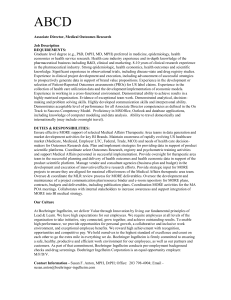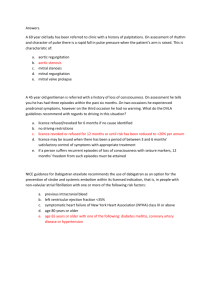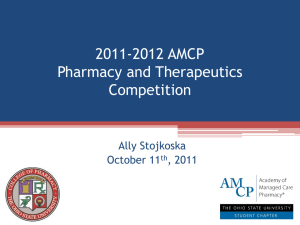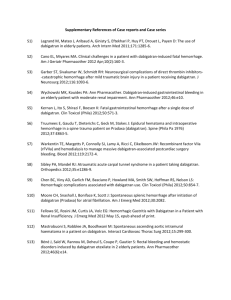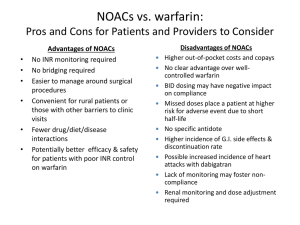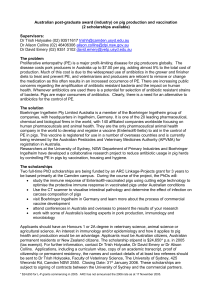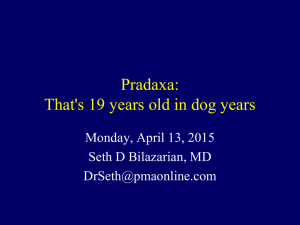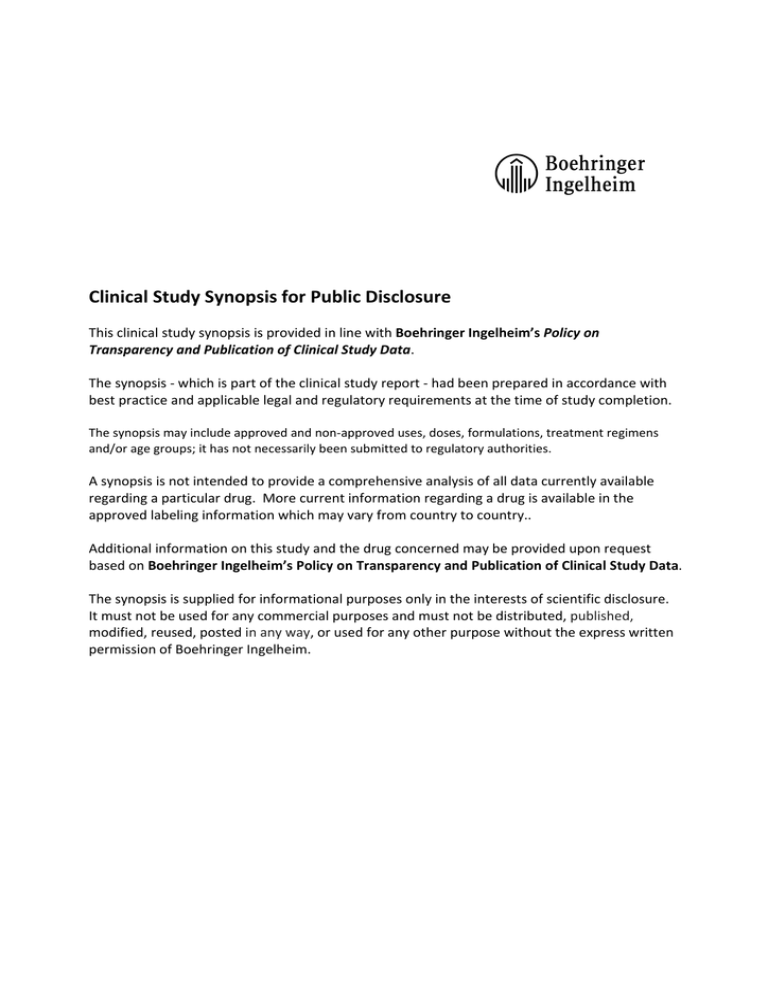
Clinical Study Synopsis for Public Disclosure abcd
This clinical study synopsis is provided in line with Boehringer Ingelheim’s Policy on Transparency and Publication of Clinical Study Data. The synopsis ‐ which is part of the clinical study report ‐ had been prepared in accordance with best practice and applicable legal and regulatory requirements at the time of study completion. The synopsis may include approved and non‐approved uses, doses, formulations, treatment regimens and/or age groups; it has not necessarily been submitted to regulatory authorities. A synopsis is not intended to provide a comprehensive analysis of all data currently available regarding a particular drug. More current information regarding a drug is available in the approved labeling information which may vary from country to country.. Additional information on this study and the drug concerned may be provided upon request based on Boehringer Ingelheim’s Policy on Transparency and Publication of Clinical Study Data. The synopsis is supplied for informational purposes only in the interests of scientific disclosure. It must not be used for any commercial purposes and must not be distributed, published, modified, reused, posted in any way, or used for any other purpose without the express written permission of Boehringer Ingelheim. Boehringer Ingelheim
Clinical Trial Report
BI Trial No.: 1160.194
Synopsis
Page 2 of 6
c02248557-02
Proprietary confidential information © 2014 Boehringer Ingelheim International GmbH or one or more of its affiliated companies
Synopsis
Name of Company:
Boehringer Ingelheim
BI Proprietary Name:
Pradaxa®
EudraCT No.:
2013-002498-23
BI Investigational Product:
Dabigatran etexilate, (BIBR 1048)
Page:
2 of 6
Report Date:
26 Sep 2014
Dates of Trial:
28 Jan 2014 –
16 Apr 2014
Trial No. / Doc. No.:
1160.194/
c02248557-02
ABCD
Date of Revision:
Not applicable
Proprietary confidential information
© 2014 Boehringer Ingelheim International GmbH or one or more of its affiliated companies. All rights reserved.
This document may not - in full or in part - be passed on, reproduced, published or otherwise used without prior written permission
Actual:
Entered:54
Dabigatran etexilate pellets on food (T1):
Treated: 54
Analysed (for primary endpoint): 54
Dabigatran etexilate granules resolved in reconstitution solution (T2):
Treated: 54
Analysed (for primary endpoint): 54
Dabigatran etexilate hard capsules (R):
Treated: 54
Analysed (for primary endpoint): 53
Diagnosis:
Not applicable
Main Criteria for
Inclusion:
Healthy male volunteers, age 18 to 55 years (inclusive), body mass index
18.5 to 29.9 kg/m2 (inclusive).
BI Investigational Product:
Dabigatran etexilate as pellets on food or granules resolved in reconstitution
solution
Dose:
Total dose of 750 mg, unit strength: 150 mg, posology: twice daily for 2 days
(1-0-1), once a day for 1 day (1-0-0)
Mode of Admin.:
Oral with 240 mL of water; on Day 3 after an overnight fast of at least 10 h
Batch Nos.:
301984 (pellets on food, out of hard capsules), B131002849 (granules for oral
solution), and B131002857 (solvent for oral solution).
Comparator Product:
Dabigatran etexilate as hard capsule
Dose:
Total dose of 750 mg, unit strength: 150 mg, posology: twice daily for 2 days
(1-0-1), once a day for 1 day (1-0-0)
Mode of Admin.:
Oral with 240 mL of water; on Day 3 after an overnight fast of at least 10 h
Batch No.:
301984 (hard capsules)
Duration of Treatment:
150 mg dabigatran etexilate twice daily on Day 1 and 2, and once on Day 3 in
each treatment period (T1; pellets on food, T2; granules resolved in
reconstitution solution, R; hard capsules) separated by a washout phase of at
least 5 days between last drug administration of one treatment and the first
drug administration of the next treatment.
Boehringer Ingelheim
Clinical Trial Report
BI Trial No.: 1160.194
Synopsis
Page 3 of 6
c02248557-02
Proprietary confidential information © 2014 Boehringer Ingelheim International GmbH or one or more of its affiliated companies
Synopsis
Name of Company:
Boehringer Ingelheim
BI Proprietary Name:
Pradaxa®
EudraCT No.:
2013-002498-23
BI Investigational Product:
Dabigatran etexilate, (BIBR 1048)
Page:
3 of 6
Report Date:
26 Sep 2014
Dates of Trial:
28 Jan 2014 –
16 Apr 2014
Trial No. / Doc. No.:
1160.194/
c02248557-02
ABCD
Date of Revision:
Not applicable
Proprietary confidential information
© 2014 Boehringer Ingelheim International GmbH or one or more of its affiliated companies. All rights reserved.
This document may not - in full or in part - be passed on, reproduced, published or otherwise used without prior written permission
Criteria for Evaluation:
Clinical
Pharmacology:
The following pharmacokinetic parameters of total dabigatran (free
dabigatran and conjugates cleaved by alkaline hydrolysis) were analysed as
primary endpoints: AUCτ, ss and Cmax, ss. As secondary endpoints AUCτ, ss and
Cmax, ss of free dabigatran were analysed.
Safety/Other:
The evaluation of safety was based on monitoring for adverse events (AEs),
clinical laboratory assessments (haematology, clinical chemistry, and
urinalysis), vital signs, 12-lead electrocardiograms (ECG), and physical
examination.
Furthermore, the assessment of palatability and acceptability, which was a
secondary endpoint, was assessed by 2 multiple choice verbal questions.
Statistical Methods:
To assess relative bioavailability, the ratios of the geometric means (each test
treatment compared with the reference treatment) for the primary and
secondary pharmacokinetic endpoints were calculated. Additionally, their 2sided 90% confidence intervals (CIs) were calculated. The statistical model
used was an analysis of variance (ANOVA) on the logarithmic scale
including effects for ‘sequence’, ‘subjects within sequences’, ‘period’ and
‘treatment’. CIs were calculated based on the residual error from ANOVA.
Descriptive statistics were calculated for all endpoints and safety assessments.
An interim analysis was not planned.
SUMMARY - CONCLUSIONS:
Trial Subjects and
Compliance with
Trial Protocol:
All 54 entered subjects completed the treatment periods and observation
times as planned. There were no important protocol violations. One subject
discontinued trial medication prematurely due to an AE, which was not
considered as drug-related by the investigator, when being treated with
dabigatran etexilate as hard capsule (R). This subject did not receive the last
planned dose. The mean age of the subjects was 36.2 years, ranging from 20
to 53 years. All subjects were male and White. Of the 54 subjects entered,
53 subjects were administered a total dose of 750 mg dabigatran etexilate
during each treatment period as planned. One subject received 600 mg
dabigatran etexilate while being treated with dabigatran etexilate as hard
capsule (R). This subject received the planned dose in both other treatments
(T1 and T2).
Boehringer Ingelheim
Clinical Trial Report
BI Trial No.: 1160.194
Synopsis
Page 4 of 6
c02248557-02
Proprietary confidential information © 2014 Boehringer Ingelheim International GmbH or one or more of its affiliated companies
Synopsis
Name of Company:
Boehringer Ingelheim
BI Proprietary Name:
Pradaxa®
EudraCT No.:
2013-002498-23
BI Investigational Product:
Dabigatran etexilate, (BIBR 1048)
Page:
4 of 6
Report Date:
26 Sep 2014
Dates of Trial:
28 Jan 2014 –
16 Apr 2014
Trial No. / Doc. No.:
1160.194/
c02248557-02
ABCD
Date of Revision:
Not applicable
Proprietary confidential information
© 2014 Boehringer Ingelheim International GmbH or one or more of its affiliated companies. All rights reserved.
This document may not - in full or in part - be passed on, reproduced, published or otherwise used without prior written permission
This relative bioavailability trial was performed to compare dabigatran
Clinical
Pharmacology Results: plasma concentrations following administration of different dosage
formulations. Inter-individual variability for Cmax,ss and AUCτ,ss values
differed between formulations, with low variability for both test formulations
and moderately high variability for the reference hard capsule formulation.
The majority of subjects had lower Cmax,ss and AUCτ,ss values for the hard
capsule formulation than for either of the test formulations. As such, the
results showed higher bioavailability of pellets on food and granules resolved
in reconstitution solution test formulations compared to the reference hard
capsule formulation. It should be noted that individuals with high peak or
average exposure after intake of dabigatran etexilate as hard capsule (R) did
not show further exposure increase with the other formulations. Trough
concentrations were similar between the 3 formulations.
Statistical analysis for the primary and secondary endpoints provided the
following results:
Boehringer Ingelheim
Clinical Trial Report
BI Trial No.: 1160.194
Synopsis
Page 5 of 6
c02248557-02
Proprietary confidential information © 2014 Boehringer Ingelheim International GmbH or one or more of its affiliated companies
Synopsis
Name of Company:
Boehringer Ingelheim
BI Proprietary Name:
Pradaxa®
EudraCT No.:
2013-002498-23
BI Investigational Product:
Dabigatran etexilate, (BIBR 1048)
Page:
5 of 6
Report Date:
26 Sep 2014
Dates of Trial:
28 Jan 2014 –
16 Apr 2014
Trial No. / Doc. No.:
1160.194/
c02248557-02
ABCD
Date of Revision:
Not applicable
Proprietary confidential information
© 2014 Boehringer Ingelheim International GmbH or one or more of its affiliated companies. All rights reserved.
This document may not - in full or in part - be passed on, reproduced, published or otherwise used without prior written permission
Clinical
Pharmacology Results
(continued):
Parameter
Adjusted
gMean ratio
[%]
2-sided 90% CI
Lower limit
[%]
Upper limit
[%]
Intra
individual
gCV [%]
Total dabigatran
Comparison pellets (T1; N = 54) vs. hard capsule (R; N = 53)
AUCτ, ss
137.0
125.8
149.3
26.8
Cmax, ss
146.2
132.2
161.6
31.6
Comparison granules (T2; N = 54) vs. hard capsule (R; N = 53)
AUCτ, ss
130.4
119.6
142.2
27.1
Cmax, ss
141.1
127.6
155.9
31.5
Free dabigatran
Comparison pellets (T1, N = 54) vs. hard capsule (R, N = 53)
AUCτ, ss
137.6
126.4
149.8
26.5
Cmax, ss
147.8
133.4
163.8
32.4
Comparison granules (T2; N = 54) vs. hard capsule (R; N = 53)
Safety Results/Other
Results:
AUCτ, ss
132.0
120.7
144.3
28.0
Cmax, ss
144.8
130.9
160.2
32.0
Deaths, SAEs, other significant AEs according to ICH E3, AEs of special
interest, or severe AEs were not reported in this study and there were no AEs
leading to trial discontinuation. A total of 21 subjects (38.9%) reported at
least 1 AE during the on-treatment phase of the study; 5 subjects (9.3%) in
the period of treatment with dabigatran etexilate as pellets on food (T1),
8 subjects (14.8%) in the period of treatment with dabigatran etexilate as
granules resolved in reconstitution solution (T2), and 10 subjects (18.5%) in
the period of treatment with dabigatran etexilate as hard capsule (R). Overall,
the most frequently reported treatment-emergent AEs on system organ class
level were nervous system disorders (14.8%), infections and infestations
Boehringer Ingelheim
Clinical Trial Report
BI Trial No.: 1160.194
Synopsis
Page 6 of 6
c02248557-02
Proprietary confidential information © 2014 Boehringer Ingelheim International GmbH or one or more of its affiliated companies
Synopsis
Name of Company:
Boehringer Ingelheim
BI Proprietary Name:
Pradaxa®
EudraCT No.:
2013-002498-23
BI Investigational Product:
Dabigatran etexilate, (BIBR 1048)
Page:
6 of 6
Report Date:
26 Sep 2014
Dates of Trial:
28 Jan 2014 –
16 Apr 2014
Trial No. / Doc. No.:
1160.194/
c02248557-02
ABCD
Date of Revision:
Not applicable
Proprietary confidential information
© 2014 Boehringer Ingelheim International GmbH or one or more of its affiliated companies. All rights reserved.
This document may not - in full or in part - be passed on, reproduced, published or otherwise used without prior written permission
Safety Results/Other
Results (continued):
(11.1%), gastrointestinal disorders (7.4%), and vascular disorders (5.6%). The
investigator classified AEs of 7 subjects (13.0%) as related to study
medication. All AEs were of mild or moderate intensity and except for 2
(paraesthesia of the fingers of mild intensity which was considered as not
drug-related by the investigator, and haematoma of mild intensity which was
considered as drug-related by the investigator), they had all resolved at the
end of the trial.
There were no clinically relevant findings with respect to laboratory
parameters, vital signs, physical examination, and 12-lead ECGs.
Multiple choice verbal questions on palatability and acceptability were
answered by 53 subjects for dabigatran etexilate as pellets on food (T1) and
by 53 subjects for dabigatran etexilate as granules resolved in reconstitution
solution (T2). Palatability and acceptability of dabigatran etexilate pellets on
food (T1) appeared to be better on a 5 category scale than that of dabigatran
etexilate as granules resolved in reconstitution solution (T2), although the
95% CIs showed overlap.
Conclusions:
Dabigatran etexilate as pellets on food (T1) and dabigatran etexilate as
granules resolved in reconstitution solution (T2) test formulations resulted in
a higher average relative bioavailability compared with the dabigatran
etexilate as hard capsule (R) reference formulation. However, individual
Cmax,ss and AUCτ,ss values observed for the 3 formulations were within the
range of exposure seen with previous dabigatran studies using capsules and
reconstitution solution. The increase in exposure is considered small enough
to consider the formulations interchangeable. Furthermore, trough levels were
similar for the 3 formulations. No conversion factor needs to be applied for
dosing purposes. Individuals with high peak or average exposure after intake
of dabigatran etexilate as hard capsule (R) did not show further exposure
increase with the other formulations.
Multiple 150 mg doses of dabigatran etexilate administrated as pellets on
food (T1), granules resolved in reconstitution solution (T2), or as hard
capsules (R) were safe and well tolerated by the healthy subjects.
Palatability and acceptability of dabigatran etexilate as pellets on food (T1)
appeared to be better on a 5 category scale than that of dabigatran etexilate as
granules resolved in reconstitution solution (T2), although the 95% CIs
showed overlap.

